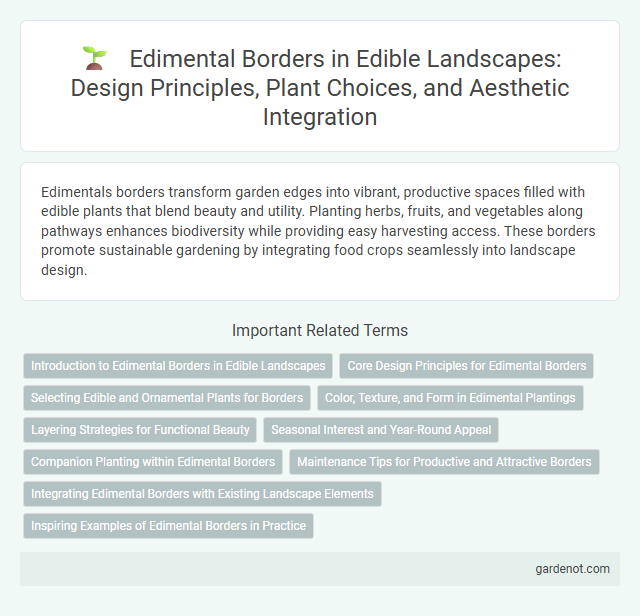Edimentals borders transform garden edges into vibrant, productive spaces filled with edible plants that blend beauty and utility. Planting herbs, fruits, and vegetables along pathways enhances biodiversity while providing easy harvesting access. These borders promote sustainable gardening by integrating food crops seamlessly into landscape design.
Introduction to Edimental Borders in Edible Landscapes
Edimental borders integrate edible plants with ornamental design, enhancing both aesthetic appeal and productivity in edible landscapes. These borders typically feature a diverse mix of herbs, vegetables, flowers, and fruit-bearing plants, creating a functional and visually attractive garden edge. Incorporating perennials like rosemary, thyme, and lavender maximizes year-round yield while supporting pollinators and soil health.
Core Design Principles for Edimental Borders
Edimental borders prioritize multifunctionality by combining aesthetic appeal with edible plantings, ensuring beauty and utility coexist in landscape design. Selection of plants emphasizes perennial edibles with staggered harvest seasons to maintain continuous yield and visual interest throughout the year. Integration of biodiversity supports soil health and pest management, reinforcing sustainable and resilient garden ecosystems.
Selecting Edible and Ornamental Plants for Borders
Choosing edible and ornamental plants for Edimentals borders involves prioritizing species that offer both aesthetic appeal and culinary value, such as perennial herbs like thyme and oregano, alongside colorful edible flowers like nasturtiums and calendulas. Incorporating native and drought-tolerant varieties ensures sustainability and low maintenance, while layering plants by height and bloom times maximizes visual interest and seasonal harvests. Strategic selection enhances biodiversity, supports pollinators, and transforms borders into productive, vibrant garden edges.
Color, Texture, and Form in Edimental Plantings
Edimentals borders showcase a vibrant palette of colors, combining deep purples, bright greens, fiery reds, and sunny yellows to elevate visual appeal while providing diverse edible yields. The textures range from the soft, velvety leaves of lamb's quarters to the crisp, succulent stems of rhubarb, creating engaging tactile contrasts that enhance garden interest and culinary use. Varied forms such as the upright spikes of sorrel, sprawling ground covers like creeping thyme, and the bold rosettes of culantro contribute structural depth and dynamic layering to these edible landscapes.
Layering Strategies for Functional Beauty
Edimentals borders utilize layering strategies that combine diverse edible plants to maximize both visual appeal and productivity. By arranging ground covers, mid-height herbs, and taller vegetables in tiered patterns, these borders create functional beauty that supports biodiversity and efficient space use. Strategic layering enhances soil health and microclimates, promoting thriving growth and continuous harvests throughout the seasons.
Seasonal Interest and Year-Round Appeal
Edimentals borders showcase a diverse array of edible plants that provide vibrant colors and textures throughout the seasons, enhancing seasonal interest in any garden. Incorporating perennials, shrubs, and annuals with staggered bloom times ensures continuous harvest and visual appeal from spring through fall. This year-round appeal not only supports biodiversity but also transforms the landscape into a productive and ornamental space.
Companion Planting within Edimental Borders
Edimental borders utilize companion planting techniques by integrating edible perennials and herbs that support each other's growth, enhance soil fertility, and deter pests naturally. Plants such as chives, nasturtiums, and borage are strategically placed to attract beneficial insects and improve nutrient cycling within the edible landscape. This symbiotic planting approach increases biodiversity and yields while maintaining aesthetic appeal in sustainable garden design.
Maintenance Tips for Productive and Attractive Borders
Edimentals borders thrive with regular pruning to control growth and encourage vigorous flowering and fruiting. Mulching with organic materials preserves soil moisture, suppresses weeds, and adds nutrients vital for plant health. Consistent watering schedules and monitoring for pests ensure a productive and visually appealing edible landscape border throughout the growing season.
Integrating Edimental Borders with Existing Landscape Elements
Edimental borders seamlessly integrate with existing landscape elements by utilizing edible plants that complement the site's natural features and soil conditions, enhancing biodiversity and aesthetic appeal. Selecting a variety of perennials, herbs, and annuals adapted to local climate zones ensures functional harmony and year-round productivity within garden edges. Incorporating native edible species alongside ornamental plants supports pollinator activity and sustainable garden ecosystems.
Inspiring Examples of Edimental Borders in Practice
Edimental borders combine edible plants and ornamental design to create visually appealing and productive garden edges, showcasing a sustainable approach to landscaping. Examples include berry shrubs interspersed with perennial herbs like rosemary and thyme, which attract pollinators while providing fresh ingredients for the kitchen. Integrating flowering vegetables such as chard or purple basil enhances both biodiversity and aesthetic value, demonstrating the multifunctional potential of edimental borders.
Edimentals border Infographic

 gardenot.com
gardenot.com